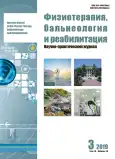Evaluation of skin ultrasound diagnostics criteria as a prognostic factor for prevention of adverse events after monopolar radio wave exposure
- 作者: Aksenenko I.P.1, Gerasimenko M.Y.2
-
隶属关系:
- Russian Medical Academy of Continuous Professional Education of the Ministry of Health of the Russian Federation
- “Aesthetic medicine clinic” Ltd
- 期: 卷 18, 编号 3 (2019)
- 页面: 140-144
- 栏目: Original studies
- URL: https://journals.rcsi.science/1681-3456/article/view/62570
- DOI: https://doi.org/10.17816/1681-3456-2019-18-3-140-144
- ID: 62570
如何引用文章
全文:
详细
The study presents data from ultrasound examination of patients’ skin in dynamics before and after exposure to the monopolar radio frequency method.
There were 41 patients aged 38 to 45 years under observation, who were divided into 2 groups: with deformed and fine-wrinkled skin types. In all groups, a single exposure was performed using the monopolar radio frequency method on the Thermage device according to the approved Protocol of operation in the face area of 1200 pulses. Objective research methods included ultrasound diagnostics before treatment, 1, 3 and 6 months after treatment. It also determined the Dermatological Quality of Life Index. The results were evaluated 1, 3 and 6 months after the treatment. The obtained data of ultrasound examination of the skin showed that the best changes in the dermis high-frequency radio wave method gave a more pronounced initial thickness of the dermis and was more effective in the deformation type of skin aging compared to fine wrinkles.
作者简介
Irina Aksenenko
Russian Medical Academy of Continuous Professional Education of the Ministry of Health of the Russian Federation
Email: mgerasimenko@list.ru
ORCID iD: 0000-0003-3602-594X
SPIN 代码: 8172-4573
俄罗斯联邦, Moscow
Marina Gerasimenko
“Aesthetic medicine clinic” Ltd
编辑信件的主要联系方式.
Email: mgerasimenko@list.ru
ORCID iD: 0000-0002-1741-7246
SPIN 代码: 7625-6452
DSc, Prof.
俄罗斯联邦, Moscow参考
- Nerobeyev AI, Malakhovskaya VI, Alikova AV. Minimum invasive radiofrequency (RF) lifting application possibilities for face and neck soft tissues’ involutional changes correction. Vestnik esteticheskoj mediciny. 2013;(1):44–50.
- Abraham MT, Ross EV. Current concepts in nonabla-tive radiofrequency rejuvenation of the lower face and neck. Facial Plast Surg 2005;21:65–73. doi: 10.1055/s-2005-871765.
- Finzi E, Spangler A. Multipass vector (mpave) technique with nonablative radiofrequency to treat facial and neck laxity. Dermatol Surg. 2005;31:916–922. doi: 10.1111/j.1524-4725.2005.31805.
- Weiss RA, Weiss MA, Munavalli G, et al. Monopolar radiofrequency facial tightening: a retrospective analysis of efficacy and safety in over 600 treatments. J Drugs Dermatol. 2006;5:707–12.
- Fritz M, Counters JT, Zelickson BD. Radiofrequency treatment for middle and lower face laxity. Arch Facial Plast Surg. 2004;6:370–3.
- De Felipe I, Del Cueto SR, Perez E, et al. Adverse reactions after non-ablative radiofrequency: follow-up of 290 patients. J Cosmet Dermatol. 2007;6:163–6. doi: 10.1111/j.1473-2165.2007.00322.x.
- De Felipe I, Redondo P. Animal model to explain fat atrophy using nonablative radiofrequency. Dermatol Surg. 2007;33:141–5. doi: 10.1111/j.1524-4725.2006.33031.x.
- Petrova GA, Gorskaya AA, Petrova KS, et al. Radiofrequency lifting effectiveness morphofunctional estimation. Vestnik esteticheskoj mediciny. 2011;4:80–84.
补充文件






